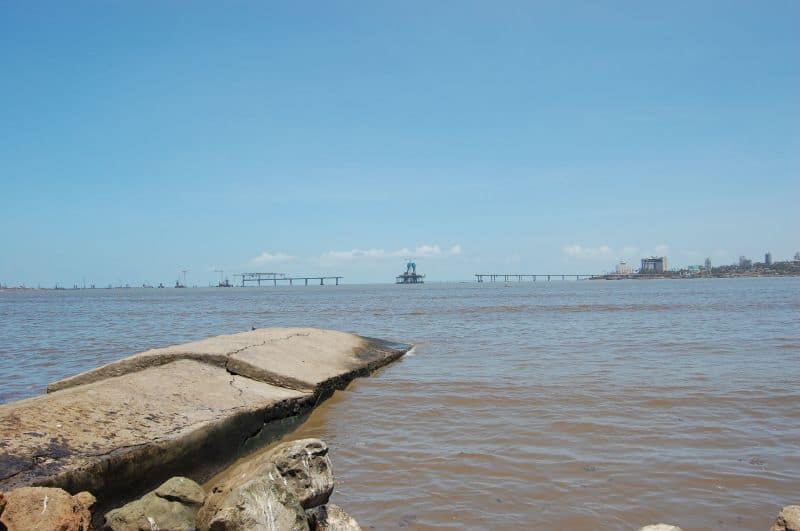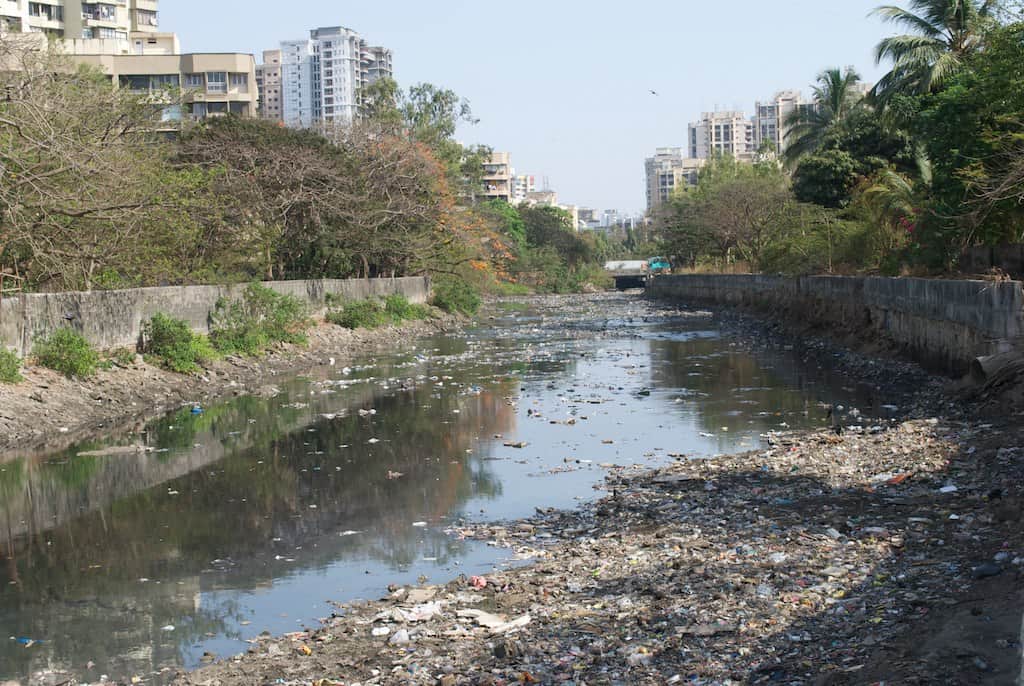With a growing population of over 12 million, Mumbai generates 2,700 – 3,000 million litres of sewage everyday. But just as water needs to be purified before it is fit for drinking, sewage needs treatment before it re-enters the water cycle. Untreated sewage is a dangerous mix of bacteria and organic matter, making it an excellent breeding ground for diseases like diarrhoea, cholera, gastroenteritis, hepatitis B, etc. Once in water, it also wreaks havoc in the environment of marine organisms, stealing from their oxygen stores, suffocating and eventually feeding on them.
At present, sewage treatment in the city is divided into seven geographical zones, collectively having eight Sewage Treatment Plants (STP). The island city has two main facilities in Colaba and Worli, while the ones at Bandra, Versova and the two in Malad and Charkop (both fall in Zone 5) handle the sewage of the western suburbs. The Bhandup and Ghatkopar plants together serve the whole of the eastern suburbs.
Apart from these, there are 54 other (as of 2014) STPs in the city, concentrated in private premises and housing societies. However, these are too small to cater to the larger public. Most have the capacity of under 1 million litre per day (MLD).

Treating sewage
Raw sewage in Mumbai travels through the 2,025-km piped network to reach the respective STP, where it is treated in multiple ways.
The first step, preliminary treatment, physically removes as many particles as possible through screening, aeration and sedimentation. The STPs in Worli, Bandra and Malad do not go any further than this step.
Secondary treatment, which is done by the plants at Versova, Bhandup and Ghatkopar, biologically degrades the organic matter in sewage using oxygen and microbes.
The third stage, tertiary treatment, chemically purifies and disinfects the wastewater to an extent that it can be reused for non-drinking and industrial purposes. But only the newest STPs, at Colaba and Charkop, can achieve this. 10 MLD of treated wastewater from the Colaba plant is intended for cleaning in army and navy establishments, but is yet to be put into practice.
The treated wastewater is currently released into a nearby waterbody. At Colaba, Worli and Bandra, a 3.5 km long pipe disperses the water into the Arabian sea. Effluents from the Malad and Versova STP drain into the Malad creek, while the Charkop plant discharges the effluent into the Gorai creek. The Bhandup and Ghatkopar STPs hold the treated sewage in aerated lagoons, from where it naturally drains into the Thane creek.
But the tale of sewage does not end here. Treatment leaves behind a residue of floating waste, grit and sludge extracted from the waste water. Barring partial conversion of sludge to manure in the Colaba and Charkop STPs, most of what is left behind is landfilled or taken to the Deonar dumping ground.
| Zone | Name | Sewage treated in dry weather (MLD) | Sewage treated in monsoon (MLD) | Treatment level | Disposal into |
|---|---|---|---|---|---|
| 1 | Colaba | 26.65 | 37 | Tertiary | Arabian sea |
| 2 | Love Grove Complex, Worli | 270.65 | 757 | Preliminary | Arabian sea |
| 3 | Bandra | 487.59 | 797 | Preliminary | Arabian sea |
| 4 | Versova | 99.94 | 180 | Secondary | Malad creek |
| 5 | Malad | 151.08 | 280 | Preliminary | Malad creek |
| 5 | Charkop | 4.57 | 6 | Tertiary | Gorai creek |
| 6 | Bhandup | 81.23 | 280 | Secondary | Thane creek |
| 7 | Ghatkopar | 103.21 | 386 | Secondary | Thane creek |
| Total | 1,226 | 2,723 |
The 8 main sewage treatment plants in Mumbai, their daily treatment capacities and outflow destinations. Data: MCGM ESR Report 2020-21 (MLD – in million litres per day)
Gaps in the system
Combined, these STPs treat 1,226 MLD of sewage in dry weather. (The volume treated in monsoon increases to 2,584, accounting for the rainwater mixed.) But the Ministry of Urban Development’s benchmark for sewage generation in a city is set at 80% of the total drinking water supply – amounting to 2,700 to 3,000 MLD of sewage in Mumbai.
This huge gap between sewage that is generated and treated is due to a few reasons. Mumbai’s sewage network covers only 84% of the city and 68% of the population, as of April 2021. Many houses – over 76,400 houses as per a 2019 count – are illegally connected to storm water drains (SWD), open nullahs and creeks. Most informal settlements – which house 42% of the population – aren’t connected to the pipe network, or have septic tanks that need to be emptied out instead.
This is meant to be done periodically with desilting and suction machines and then rerouted into the existing pipes, but plays out very differently in practice. Cleaning is done infrequently, and the overflow flows into SWDs. And while the BMC has time and time again announced the purchase of machines, the reality is that workers, a majority among them hailing from lower castes, often manually clean the tanks without safety gear, at great risk to their health and life. Mumbai scored -43.17 out of 400 for ‘Mechanised Cleaning & Machine’ use in the 2021 Safaimitra Suraksha Challenge report, which ranked urban local bodies (ULB) on safety parameters for sanitation workers.
From the nullahs and creeks into the rivers and sea, the destination of this sewage remains the same. But without any treatment, the raw and toxic wastewater carries all its pollutants into the water bodies.
In July 2021, the BMC admitted to releasing 747 MLD of untreated sewage from over 84 SWD outfalls into four rivers. The Mithi river is subject to the most effluents, due to its central location and the informal settlements and illegal industries on its banks. Over time, this has emptied the river of all its freshwater, leading to the environment minister Ramdas Kadam declaring it as “100% sewage” in 2015.
The Poisar river, Dahisar river and Oshiwara river receive the rest of the effluents.
Read more: Why fishermen in suburban Mumbai find their catch shrinking steadily
Poor results
In 2017, the environmental NGO Vanashakti filed a plea against the dumping of untreated sewage into waterbodies with the National Green Tribunal (NGT). In response, the NGT fined the BMC with a penalty of Rs 29.75 crore, with an additional Rs 4.25 crore every month till treatment started. But it did not stop there.
The NGT further instructed the Central Pollution Control Board (CPCB) to examine the functioning of the eight STPs, and charge the BMC Rs 10 lakh for every operational deficiency.
In the meantime, they also made treatment standards of effluents from STPs stricter. Maximum permitted levels of biochemical oxygen demand (BOD) were decreased from 50 mg/ltr to 10 mg/ltr; total solid suspended (TSS) from 50 mg/ltr to 20 mg/ltr; and faecal coliform (FC) levels were set at 100 MPN/100 ml. To comply with these standards, however, the plants were given a grace period of five years.
On examining the STPs in November 2020, the CPCB found that only two of the eight, at Colaba and Charkop, were capable of meeting the old standards, to say nothing of the new ones. The plant in Malad fared the worst, violating standards on eight counts between April and November 2020.
With 21 violations in total, the environmental compensation the BMC was asked to pay increased by Rs 2.1 crores. The culmination of these fines was Rs 36 crore – a fine it is yet to pay.

What’s next
A large part of the reason that STPs fail to meet standards is that they are old and underdeveloped. The STPs in Worli, Versova and Malad have been working since the 1990s, when the requirements of treatment were considerably lower. Even then, environmentalists had raised questions about their efficacy.
The BMC was meant to strategically repair the system bit by bit under its 1999 Mumbai Sewage Disposal Project-II by repairing and laying new sewer lines and upgrading the sewage pumping stations and STPs. But this has been slow.
Sewer lines 93.68 km in length are planned under the Municipal Sewerage Improvement Programme (MSIP), but only 15.50 km has been laid. A further 143.19 km of pipes are intended on undeveloped and encroached roads, but will only come to fruition with the development of slum redevelopment schemes in the areas.
To prevent sewage entering the rivers, tendering of sewage lines and smaller STPs along the banks of the Mithi, Dahisar, Poisar and Oshiwara rivers are in progress.
Upgrades to the STPs at Worli, Bandra, Malad, Versova, Ghatkopar, and Bhandup and the construction of a new one at Dharavi have been up in the air. The first master plan was scrapped after the Maharashtra Pollution Control Board (MPCB) changed pollution norms in 2007, and then delayed till 2015 by the consultant. When tenders were finally invited in 2018, a case in the NGT over pollution norms put contracting on hold. Tenders were re-invited, scrapped and re-invited again in 2020, due to the pandemic, a poor response, cost escalations, and allegations of favoritism.
Fresh tenders were floated for the 4th time in February 2022. The cost of construction, in the meantime, has increased fourfold, from Rs 5,500 crore in 2009 to over Rs 20,000 crore.
The new plants will have a combined capacity of 2,464 MLD, half of which will undergo tertiary treatment and be reused. But while the tentative date of completion is by 2027, there is no telling how far the delays might push it back.
You can make a difference
The BMC incentivises housing societies that use recycled water from STP with a 5% property tax rebate. It is also mandatory for developing housing projects with areas above 20,000 sq metre to have a STP of their own, to meet any excess water needs. But despite construction, high maintenance costs deter societies from putting them into use.
- Bio-STPs, or green STPs, have emerged as an alternative to the expensive and energy-draining STPs. They require comparatively less maintenance, space and might be the more viable option for many.
- The gated community app MyGate can get you started with information on a STP in your housing society.
- Builders are responsible for STP maintenance for five years after occupancy by residents. You can make sure the plant stays operational during that time and after.
This explainer is part of a series on ‘Explainers and Information Resources for Mumbaikars’ supported by a grant from the A.T.E. Chandra Foundation.